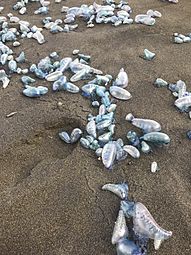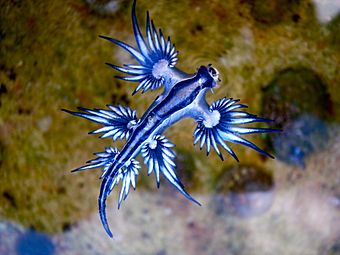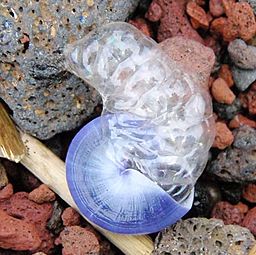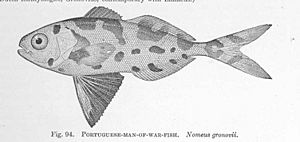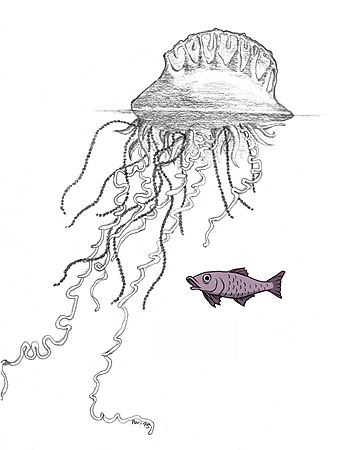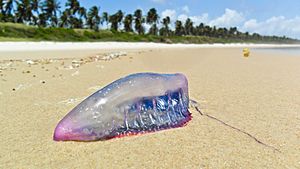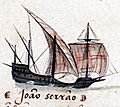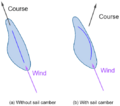Portuguese man o' war facts for kids
Quick facts for kids Portuguese man o' war |
|
|---|---|
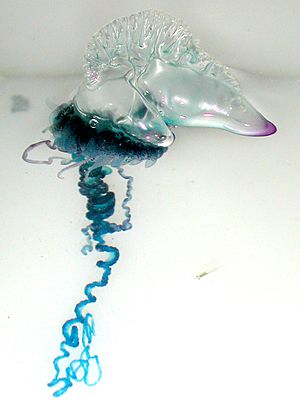 |
|
| Scientific classification | |
| Kingdom: | |
| Phylum: | |
| Class: | |
| Order: | |
| Family: |
Physaliidae
|
| Binomial name | |
| Physalia physalis (Linnaeus, 1758)
|
|
The Portuguese man o' war (Physalia physalis) is a sea animal related to jellyfish. It lives in the ocean. People sometimes call it the blue bubble or man-of-war. Its name comes from old Portuguese warships. These ships had triangular sails. The man o' war's bladder looks similar to these sails.
The Portuguese man o' war is known for swimming in huge groups. It is also famous for its very powerful sting.
Contents
What is a Portuguese Man o' War?
The Physalia is not just one animal. It is a siphonophore. This means it is a colony made of four different kinds of tiny living parts called zooids. These zooids are like very small, changed individuals. They are special polyps and medusoids.
Even though they look like other cnidarians, these zooids cannot live alone. They are all connected to each other. Each type of zooid has a special job. It depends on the others to do what it cannot do by itself. They all work together to survive.
Body Parts and How They Work
The most noticeable part of the man o' war is its bladder, also called a pneumatophore. This bladder is clear and can be blue, purple, pink, or mauve. It can be about 9 to 30 cm (3.5 to 12 in) long. It can float as high as 15 cm (6 in) above the water.
The bladder helps the colony float and acts like a sail. This lets the colony move with the wind. The gas inside the bladder is partly carbon monoxide. The animal makes this gas itself. It also has gases from the air around it. If something attacks from the surface, the bladder can deflate. This lets the colony sink underwater for a short time.
The colony catches and eats food using two types of zooids. These are called gastrozooids and dactylozooids. Gastrozooids are for feeding. Dactylozooids have tentacles. These tentacles are usually about 10 m (33 ft) long. But they can grow to over 30 m (98 ft) long!
Each tentacle has tiny, coiled, thread-like parts called nematocysts. When something touches them, these nematocysts fire. They inject venom. This venom stings, paralyzes, and kills small squids and fish.
Where They Live
Portuguese man o' war are mostly found in warm, tropical, and subtropical waters. They live on the surface of the ocean. Their gas-filled bladder stays on top of the water. The rest of the colony stays underwater.
Portuguese man o' war cannot move by themselves. They are carried by the winds, ocean currents, and tides. Strong winds can push them into bays or onto beaches. If you find one man o' war on a beach, you will often find many others nearby.
Beachgoers know them well because of their painful stings. Even when they are on the beach, they can still sting. Because of this, a beach might be closed if many man o' war wash ashore.
Left and Right Floats
Each man o' war can have its float leaning to the left or to the right. This is called dimorphism. Scientists think this helps prevent all of them from washing ashore and dying.
"Left-handed" man o' war sail to the right of the wind. "Right-handed" ones sail to the left. The wind will always push these two types in different directions. This way, at most, only half of the population will be pushed towards the coast.
Man o' war from different areas can have different float sizes. They can also have different numbers of long hunting tentacles. For example, a smaller type, sometimes called a bluebottle, has a float rarely bigger than 10 cm (4 in). It has only one long hunting tentacle, less than 3 m (10 ft) long. The typical man o' war has a float around 15 cm (6 in). It can be up to 30 cm (12 in). It also has several hunting tentacles that can reach 30 m (98 ft) when fully stretched out.
What They Eat and Who Eats Them
The Portuguese man o' war is a carnivore. This means it eats meat. It uses its venomous tentacles to trap and paralyze its prey. Then, it pulls the prey towards its digestive parts. It usually eats small adult fish and young fish. Sometimes it also eats zooplankton, shrimp, and other small crustaceans.
Few animals hunt the Portuguese man o' war. One animal that does is the loggerhead turtle. Man o' war are a common part of its diet. The turtle's skin, even on its tongue and throat, is too thick for the stings to get through.
Also, the blue sea slug Glaucus atlanticus eats only Portuguese man o' war. The violet snail Janthina janthina does too. The ocean sunfish also eats them.
The blanket octopus is not affected by the man o' war's venom. Young blanket octopuses have been seen carrying broken man o' war tentacles. Male and young female octopuses rip these off and use them to attack or defend themselves.
The man-of-war fish (Nomeus gronovii) lives near the Portuguese man o' war. This fish lives in the Atlantic, Pacific, and Indian Oceans. It can live safely among the man o' war's deadly tentacles. It even eats the tentacles and other parts of the man o' war.
This fish does not use a slimy coating to stop the stings. Instead, it swims very quickly and carefully to avoid the tentacles. The fish has many vertebrae (41), which might help it move so fast. It mostly uses its front fins for swimming. This is common for fish that need to move in small spaces. It also has special skin and at least one antibody against the man o' war's toxins. Even though it is 10 times more resistant to the toxin than other fish, the large stinging tentacles can still sting it. The fish actively avoids these. The smaller tentacles do not seem to sting the fish. The fish often "nibbles" on these smaller tentacles.
Living Together: Commensalism
The Portuguese man o' war is often found with other sea fish, like yellow jack. These fish get shelter from predators because of the stinging tentacles. For the Portuguese man o' war, having these fish around might attract other fish for it to eat.
Life Cycle and Reproduction
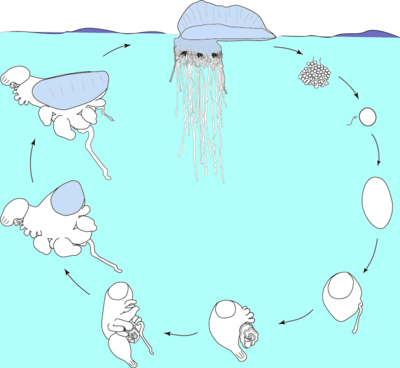
Each man o' war is either male or female. They usually mate in the autumn. During this time, they release eggs and sperm into the water.
A fertilized man o' war egg grows into a larva. As it grows, new zooids bud off from it. This slowly forms a new colony. This early growth happens underwater. Scientists have learned about it by studying different stages of larvae found in the sea.
The first two parts to appear are the pneumatophore (sail) and a single, early feeding zooid. Later, more feeding zooids and tentacle-bearing zooids are added. Eventually, the growing pneumatophore becomes light enough to carry the young colony to the surface of the water.
Venom and Stings
The stinging, venom-filled nematocysts in the tentacles can paralyze small fish and other prey. Even tentacles that have broken off can sting. Dead man o' war, including those washed ashore, can sting just as painfully. Their venom can stay strong for hours or even days after the animal dies or a tentacle breaks off.
Stings usually cause severe pain to humans. They leave red marks on the skin that look like whip marks. These marks usually last two or three days. The pain typically goes away after about one to three hours. This depends on the person.
However, the venom can travel to the lymph nodes. It might cause symptoms like an allergic reaction. These can include swelling in the throat, trouble breathing, and heart problems. Other symptoms can be fever and shock. In very rare cases, it can even cause death.
If someone is stung by many tentacles, they might need medical help. This is to ease the pain or help them breathe. This is especially true if the pain is very bad or lasts more than three hours. Stings that cover a young child's body can be very dangerous.
In Australia, the Portuguese man o' war causes up to 10,000 human stings each summer. Most of these happen on the east coast. Some also occur off the coasts of South Australia and Western Australia.
Treating Stings
Stings from a Portuguese man o' war can cause a severe skin rash. This rash has long, thin, open wounds. They look like whip marks. These marks are not from hitting or cutting. They are caused by irritating substances in the tentacles.
Images for kids
-
The name comes from a resemblance of the animal to a sailing warship, the Portuguese man-of-war (the caravel circa 1500)
See also
 In Spanish: Carabela portuguesa para niños
In Spanish: Carabela portuguesa para niños



